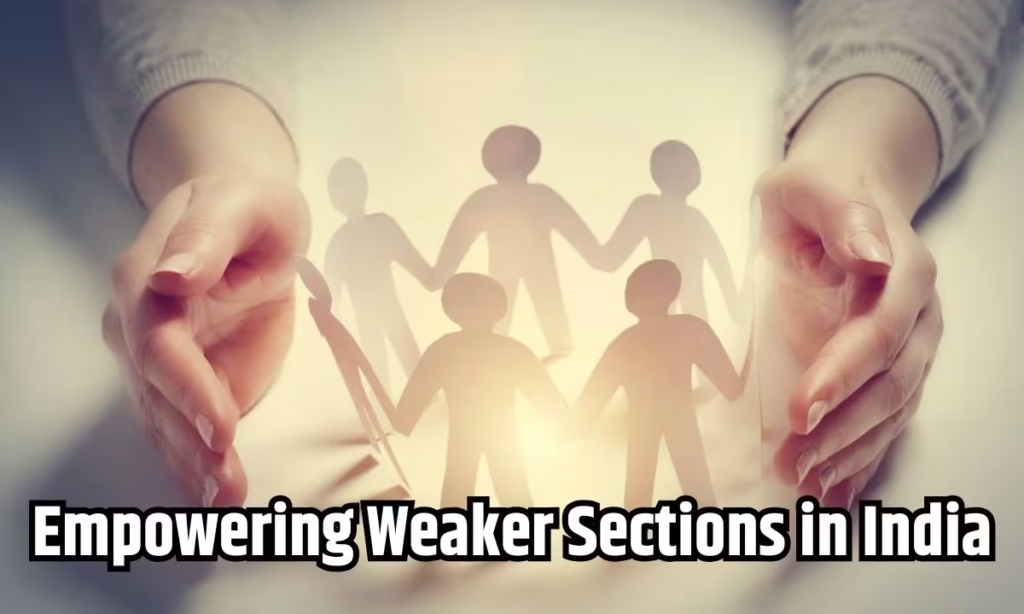Empowering Weaker Sections in India: In the vibrant tapestry of India, where diversity thrives alongside disparities, the empowerment of weaker sections stands as a cornerstone for true progress. Imagine a young woman from a remote village, once confined by societal norms and economic barriers, now leading a self-help group that generates income for her community. This isn’t just a dream—it’s a reality unfolding across the nation through targeted efforts.
Weaker sections, often including scheduled castes, scheduled tribes, women, economically backward classes, and persons with disabilities, face systemic challenges that hinder their growth. Yet, with strategic empowerment, they can unlock their potential, contributing to inclusive development. This blog post dives deep into the essence of empowerment, exploring government schemes, societal roles, hurdles, and triumphs. Whether you’re a policymaker, activist, or curious reader, you’ll find actionable insights to understand and support this vital cause.
Who Are the Weaker Sections?
Weaker sections refer to groups in society that have historically been marginalized due to social, economic, or physical disadvantages. In India, this term encompasses scheduled castes (SCs), scheduled tribes (STs), other backward classes (OBCs), women, children, the elderly, and people with disabilities. These communities often grapple with poverty, limited access to education, healthcare, and employment opportunities.
For instance, scheduled castes, formerly known as Dalits, have faced centuries of discrimination, while tribal groups in remote areas struggle with isolation and lack of infrastructure. Women, despite comprising nearly half the population, encounter gender-based inequalities, and economically weaker sections (EWS) from general castes now benefit from reservations to level the playing field. The Constitution of India recognizes these vulnerabilities, mandating affirmative actions like reservations in education and jobs to uplift them.
Understanding these groups is crucial because empowerment isn’t a one-size-fits-all approach. It requires tailored strategies that address specific needs, such as cultural preservation for tribes or skill training for urban poor.
Why Empowerment Matters
Empowerment goes beyond charity—it’s about enabling self-reliance and dignity. When weaker sections are empowered, society as a whole benefits. Economically, it boosts GDP by integrating untapped talent into the workforce. Socially, it reduces inequalities, fostering harmony and reducing conflicts.
Consider the ripple effect: An educated girl from a weaker section can break the cycle of poverty for her family, leading to healthier children and stronger communities. Studies show that investing in women’s empowerment yields high returns, with each rupee spent generating multiple times in societal gains. Moreover, in a democracy like India, true progress is measured by how well the most vulnerable are uplifted. Without empowerment, issues like malnutrition, unemployment, and social unrest persist, hindering national goals like Sustainable Development Goals (SDGs).
Empowerment also promotes innovation. Marginalized voices bring unique perspectives, driving creative solutions to problems like climate change or rural development. In essence, it’s not just moral—it’s essential for sustainable growth.
Government Initiatives and Schemes
The Indian government has launched numerous schemes to empower weaker sections, focusing on financial inclusion, education, and health. One flagship program is the Pradhan Mantri Jan Dhan Yojana (PMJDY), which has opened millions of bank accounts for the unbanked, enabling direct benefit transfers (DBT) and reducing leakages in welfare distribution. Through DBT, schemes like the National Social Assistance Programme provide pensions to the elderly and disabled from weaker backgrounds.
For women, Beti Bachao Beti Padhao campaigns against female foeticide while promoting education, and the Mahila Samridhi Yojana offers financial aid to economically weaker women. The MUDRA Yojana supports micro-entrepreneurs, with a significant portion benefiting SC/ST and OBC communities. In education, scholarships under the Post-Matric Scholarship Scheme help students from weaker sections pursue higher studies.
Recent initiatives under Modi 3.0 emphasize middle-class and weaker section growth through tax reforms, pension enhancements, and housing under Pradhan Mantri Awas Yojana (PMAY), which prioritizes SC/ST and EWS families. For persons with disabilities, the Accessible India Campaign improves infrastructure, while schemes like Deen Dayal Disabled Rehabilitation Scheme offer vocational training.
These programs are backed by reservations: 10% for EWS in jobs and education, alongside traditional quotas for SC/ST/OBC. However, success depends on effective implementation, with digital tools like Aadhaar ensuring transparency.
Role of NGOs and Civil Society
While government schemes lay the foundation, non-governmental organizations (NGOs) and civil society play a pivotal role in grassroots empowerment. Groups like Self-Employed Women’s Association (SEWA) have organized women workers, providing training in crafts and finance to achieve economic independence.
Corporate Social Responsibility (CSR) initiatives also contribute significantly. Companies invest in skill development programs for weaker sections, such as vocational training in IT or agriculture. Cooperatives, especially for weaker sections, foster collective bargaining, as seen in dairy cooperatives that empower rural farmers.
Community-based organizations focus on awareness, running campaigns against child labor or domestic violence. International bodies like UNICEF partner with local NGOs to address tribal health issues. The key is collaboration: NGOs bridge gaps where government reach is limited, ensuring schemes translate into real change.
Youth-led initiatives are emerging, with volunteers mentoring underprivileged children, amplifying voices through social media. This collective effort creates a supportive ecosystem for sustained empowerment.
Economic Empowerment Strategies
Economic independence is a game-changer for weaker sections. Strategies include microfinance, skill development, and entrepreneurship promotion. Self-help groups (SHGs) under the National Rural Livelihood Mission (NRLM) have empowered millions of women by providing loans and market linkages.
For urban poor, programs like Skill India offer training in high-demand sectors like healthcare and tourism. Agricultural reforms benefit tribal farmers through better irrigation and crop insurance under PM Krishi Sinchayee Yojana.
Financial literacy is crucial, teaching budgeting and investment to prevent debt traps. Success lies in inclusive policies, like reserving contracts for SC/ST entrepreneurs in public procurement. By fostering startups in weaker communities, India can harness demographic dividends, turning challenges into opportunities for growth.
Educational and Skill Development Programs
Education is the bedrock of empowerment. Initiatives like Sarva Shiksha Abhiyan ensure universal elementary education, with special focus on girls and SC/ST children. Mid-Day Meal Scheme combats malnutrition, encouraging school attendance.
Higher education sees scholarships and hostels for weaker students, while digital platforms like SWAYAM provide free online courses. Skill development under Pradhan Mantri Kaushal Vikas Yojana (PMKVY) equips youth with job-ready skills, from plumbing to coding.
For disabled individuals, inclusive education policies integrate them into mainstream schools. These programs not only impart knowledge but build confidence, enabling weaker sections to compete equally in the job market.
Challenges in Empowerment
Despite progress, challenges abound. Implementation gaps, such as corruption or bureaucratic delays, hinder scheme benefits from reaching the needy. Social stigma persists, with discrimination against SC/ST in workplaces.
Geographical barriers affect tribal areas, where poor infrastructure limits access. Gender biases exacerbate issues for women, and economic volatility impacts the vulnerable most. Lack of awareness about schemes is another hurdle, often leaving eligible beneficiaries out.
Climate change adds pressure, displacing weaker communities. Addressing these requires policy reforms, community involvement, and monitoring mechanisms to ensure accountability.
Inspiring Success Stories
Real change shines through stories. In Chandigarh, youth from economically weaker sections have turned lives around via empowerment programs, becoming entrepreneurs and educators. Rural women under NRLM have formed SHGs, achieving financial autonomy and community leadership.
A tribal woman in Odisha, once struggling with poverty, now runs a successful organic farming venture, thanks to government subsidies and NGO training. In Bihar, DBT schemes have empowered 75 lakh women with direct cash transfers, boosting household economies.
These tales highlight resilience and the power of support systems, inspiring others to pursue dreams.
Conclusion: Empowering Weaker Sections in India
Empowering weaker sections isn’t optional—it’s imperative for India’s journey toward equality and prosperity. From government schemes fostering inclusion to civil society’s grassroots efforts, the path is paved with promise. Yet, challenges remind us that sustained commitment is key. By celebrating success stories and addressing gaps, we can build a nation where everyone thrives. Let’s pledge to support these initiatives, ensuring no one is left behind. Together, we can turn empowerment into a reality for all.
FAQ About Empowering Weaker Sections in India
What does ‘weaker sections’ mean in India?
Weaker sections include socially and economically disadvantaged groups like SCs, STs, OBCs, women, and EWS, protected under constitutional provisions.
How can individuals contribute to empowerment?
Volunteer with NGOs, support local businesses from weaker communities, or spread awareness about schemes through social media.
What are key government schemes for women empowerment?
Programs like Beti Bachao Beti Padhao, Ujjwala Yojana for LPG connections, and Stand-Up India for loans target women’s upliftment.
Are there success stories of tribal empowerment?
Yes, many tribes have benefited from forest rights under FRA, leading to sustainable livelihoods in eco-tourism and handicrafts.
What challenges do empowerment initiatives face?
Issues include poor implementation, lack of funds, and societal resistance, but ongoing reforms aim to overcome them.
How does education empower weaker sections?
It provides knowledge, skills, and opportunities, breaking poverty cycles and enabling better jobs.

